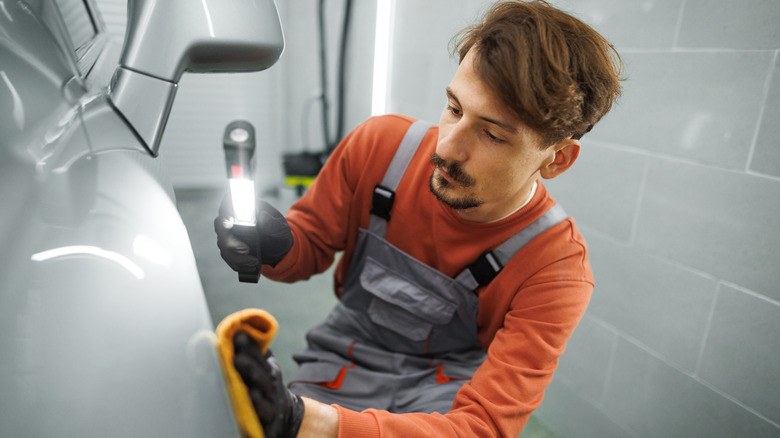
Mixetto/Getty Images
We may receive a commission on purchases made from links.
Cars are an absolute magnet for dirt, smudges, foreign substances, and a myriad of other assorted grossness, possibly more than anything else you could own. Even if you don’t drive your car around that much, if it’s parked outside on a regular basis, it’s going to get dirty again with or without your input. Naturally, the best and simplest solution for a dirty car is to take it to the local car wash for a quick scrub down, but that may not always get your car as clean as you like, and that’s assuming the car wash process doesn’t do more harm than good.
If you want to get your car deep cleaned, the next best option would be to schedule a detailing appointment at your local upscale garage, though this can be a bit pricey and leave you without your vehicle for multiple hours. If you’d prefer to handle your car’s deep cleaning on your own, it’s more than possible, so long as you’ve got the time, gumption, and perhaps most importantly, cash on hand to get the necessary tools and materials. Remember, professional-grade car cleaning tools aren’t cheap, but if you get them yourself, you can use them over and over.
Use a spot cleaner on stubborn interior dirt
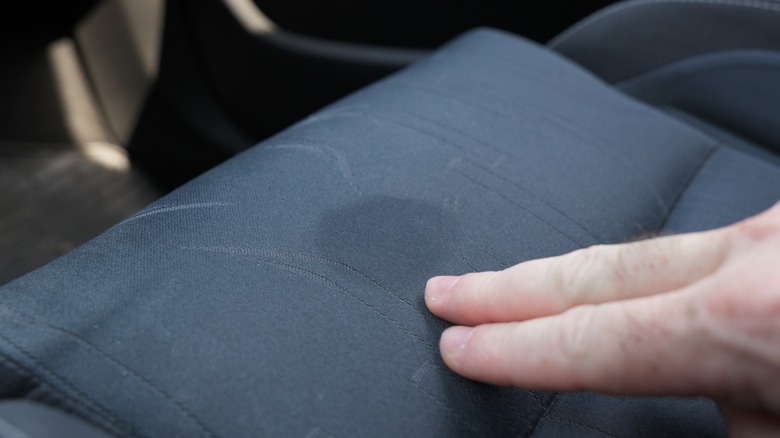
Vlamin/Shutterstock
Whether you work a labor-intensive job or just have a bunch of rowdy, nature-loving kids, your car’s interior will eventually get covered in spots and dots. A bit of forceful scrubbing can remove the lion’s share of these unsightly spots, but there always seems to be at least one that clings firmly to your seats and upholstery. It might not bother you as much if it’s a spot that usually has someone sitting on it, but if it’s constantly staring you in the face, it needs to go.
Much like how you would clean a carpet stain in your home, the solution for stubborn car spots is a spot cleaner. These tools use a combination of powerful sprays and suction to attack densely packed spots with cleaning solutions, then immediately capture the loosened contaminants before they have a chance to resettle. Not only are these great for general deep cleaning, but they’re a lifesaver in the event of a dreaded pet travel accident. Spot cleaners typically cost around $100 to purchase, but if there’s a hardware store near you like Home Depot, you can rent one for around $20.
Scrub removable parts with an ultrasonic cleaner
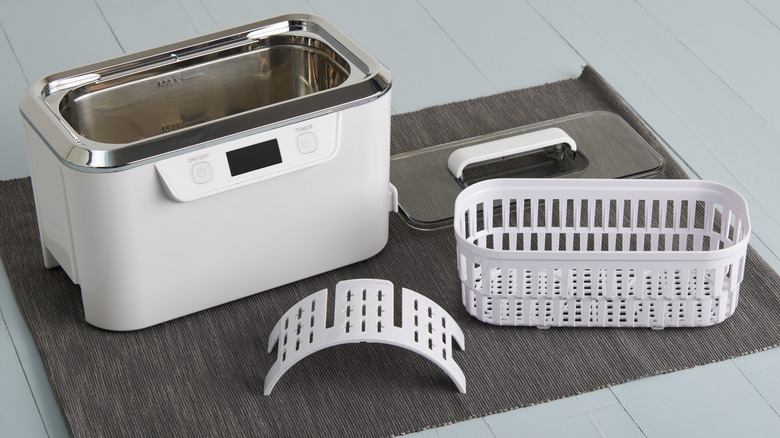
JIPEN/Shutterstock
Have you ever made the ill-informed decision of opening a can of soda or coffee in your car, only to have its contents go flying all over the place? It’s bad enough when your seats and upholstery get coated in contaminants, but what about the buttons, switches, and knobs on your dashboard? Even if nothing gets into the critical parts, you’re still stuck with sticky, dust-attracting switches that will feel unpleasant to push. If you quickly tackle it with a rag and some isopropyl alcohol, it shouldn’t be a problem, but if you leave that gunk all over your switches long-term, they’ll become encrusted with grime that only gets worse as time goes on. If you’d rather not spend an afternoon slowly picking it all off with a toothpick, try an ultrasonic cleaner.
Ultrasonic cleaners are like tiny dishwashers, cleaning small objects with a combination of water, cleaning solutions, and powerful vibrations. While these devices are intended more for things like jewelry and small mechanical parts, you can dump a few sticky switches in there as well with no problems. Just run them through a scrub cycle, and they’ll be nice and clean and ready for reinsertion. It’s great for really nasty jobs in general and as part of the restoration process for old, neglected cars. Some ultrasonic cleaners can be on the expensive side, but you can get a simple one off from Amazon for around $30 to $40.
Use a cleaning gun to deep clean crevices
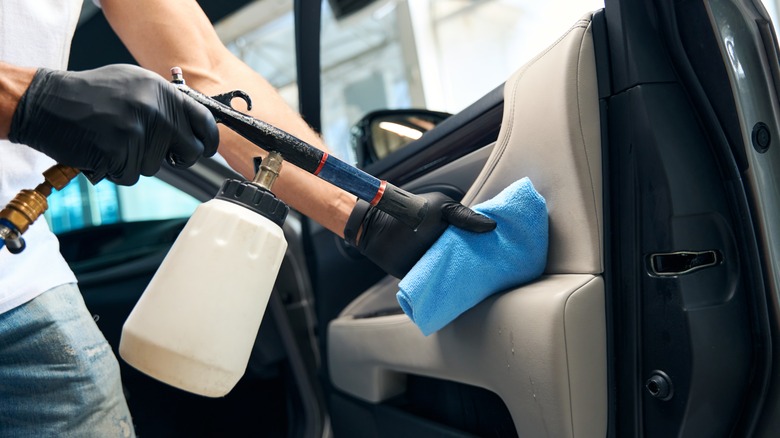
Svitlana Hulko/Shutterstock
If you’re looking to deep clean your car, a bucket of soapy water and a stack of clean towels are only the absolute minimum of required tools. Some simple scrubbing will help to remove surface-level grime, but if it’s been a while since your last cleaning, there will likely be a lot of extra contaminants out of sight, lodged deep into your car’s various nooks and crannies.
It’s for this reason that professional detailers tend to employ high-powered car cleaning guns. These devices are hooked up to an air compressor and a cleaning solution tank to blast away grossness with both speed and power. This kind of cleaning muscle can easily remove visible contaminants, but the powerful streams they shoot are excellent for deep-cleaning tricky spots like the seams on your car’s body or foldable components like convertible tops. Unfortunately, powerful equipment demands high costs, with cleaning guns from prominent brands like Tornador running over $200, though you may be able to find some cheaper models on Amazon.
Remove sticky substances with clay bars
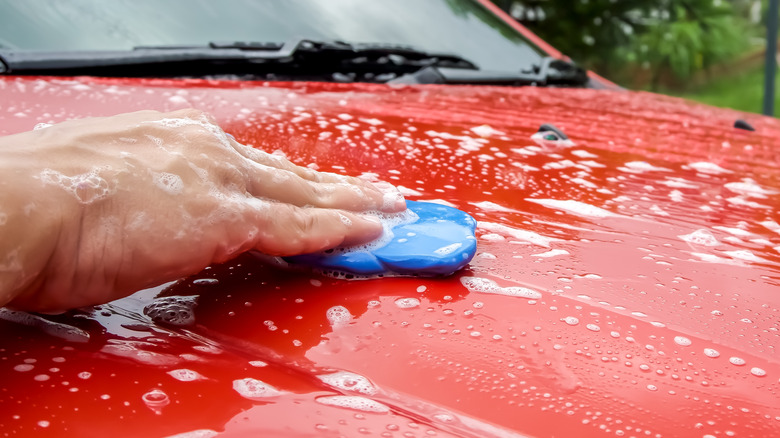
CK2 Connect Studio/Shutterstock
Depending on where you live, the exterior of your car may be subjected to various sticky substances as you drive around. Trips by the sea could leave your car covered in salty seaspray, treks through the forest can result in lumps of tree sap on the hood, and even a regular cruise down the highway can result in a vile galaxy of bug splatters across the entire front. These are collectively known as bonded contaminants due to their tendency to stick fast, no matter how hard you try to scrub them off. Rather than using harsh brushes and cleaners to loosen these contaminants, you need a specialized tool to safely peel them off.
For removing bonded contaminants, the professional tool of choice is a clay bar. It’s exactly what it sounds like: a bar of non-abrasive clay that you rub on any bonded contaminants stuck to your car’s exterior. Clay bars are specially formulated to grab onto bonded contaminants and soften them up, lifting them up and off as you scrub, all without damaging or scuffing your car’s finish. If there are any contaminants left after a good claying, they’ll usually be soft enough that you can pluck them right off with a microfiber towel. You can get a pack of clay bars online or at an auto goods retailer for around $15.
Apply wax to seal in the freshness
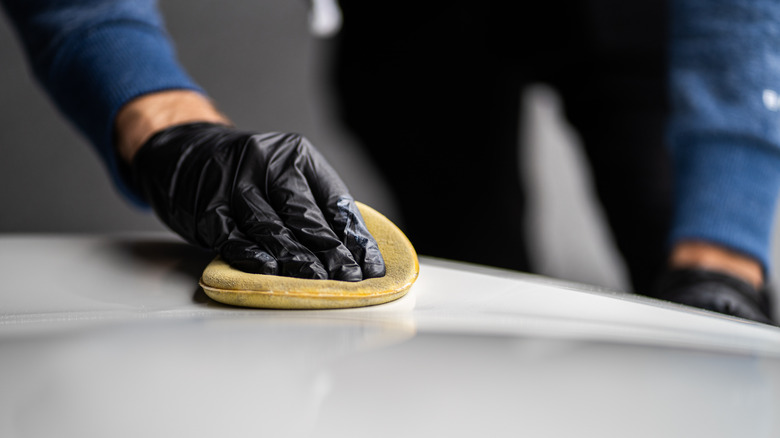
WATCH_MEDIA_HOUSE/Shutterstock
So, you’ve given the exterior of your car the cleaning of a lifetime. All of the unsightly spots and bug splats have finally been excised from the hood and sides, leaving your car looking more resplendent than when it first rolled off the lot. Is it time to pack it in for the day? No, leaving now would be one of many big mistakes you could make with car upkeep. There’s still one thing you need to consider: keeping your car’s new sheen for as long as possible. No matter how clean you manage to get it, it will invariably get dirty, meaning you’ll need to expend the energy to clean it all over again. However, you can increase the lifespan of that cleaning job with some preventative measures.
You know how, at the regular car wash, they usually blast your car’s exterior with Turtle Wax after all the washing and scrubbing is done? There’s a reason for that: wax helps seal your car’s shiny finish, creating a protective layer over everything to help it repel contaminants. You can grab a can of high-grade paste wax online and at most automotive stores for around $15 and carefully apply it around the exterior to preserve your hard work. A bit of waxing will give your exterior the protection it needs while also exemplifying the shine of its finish.